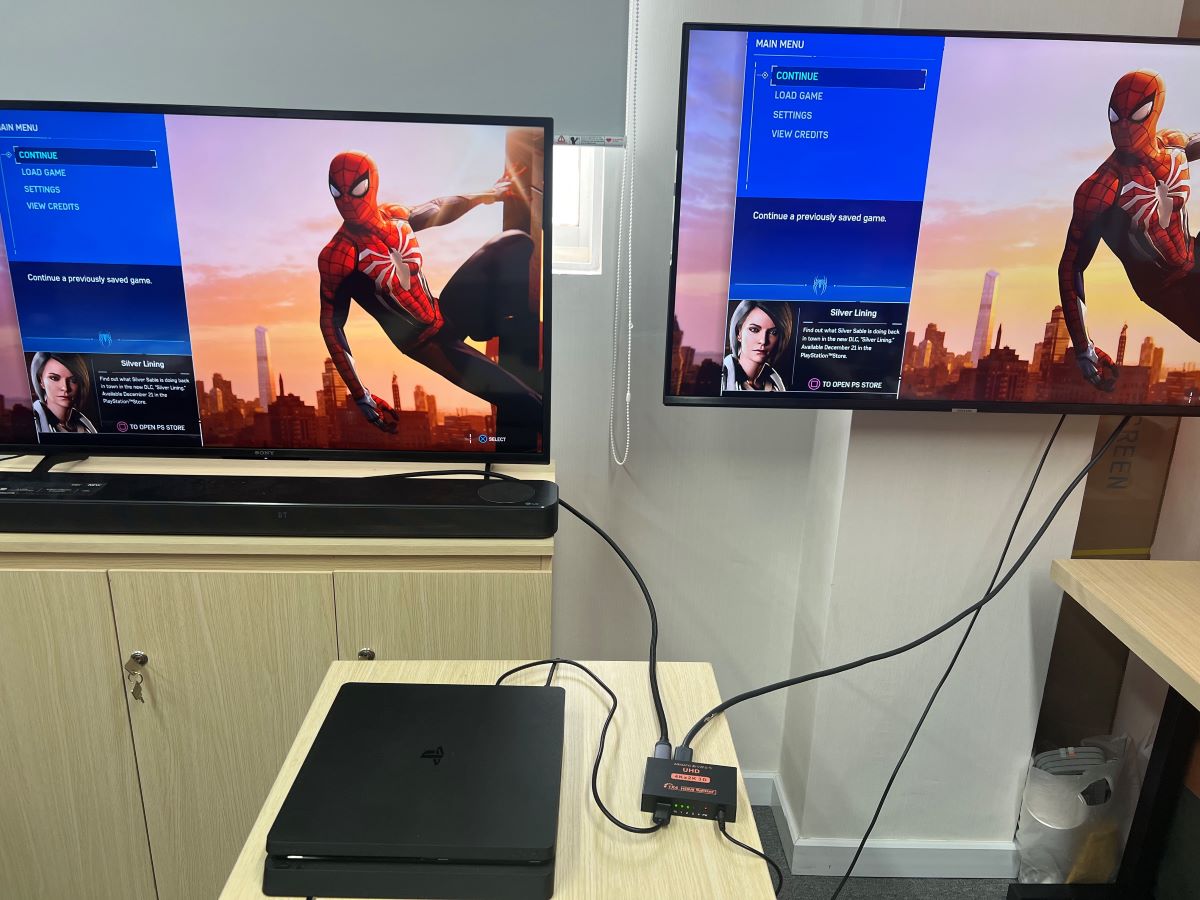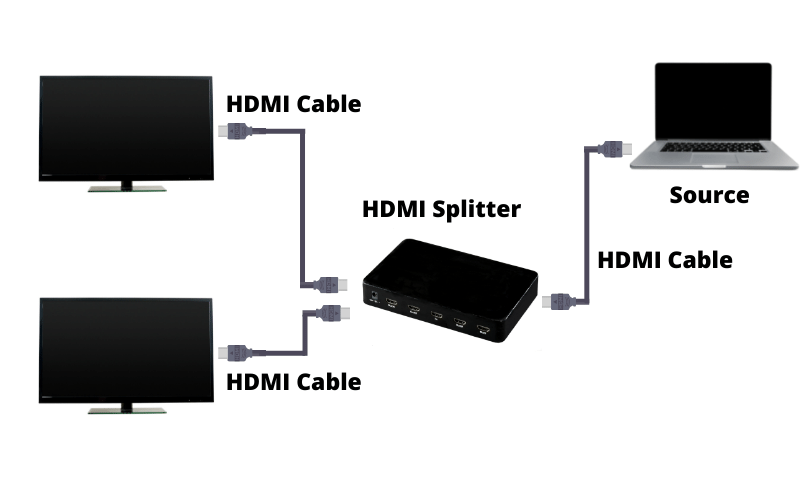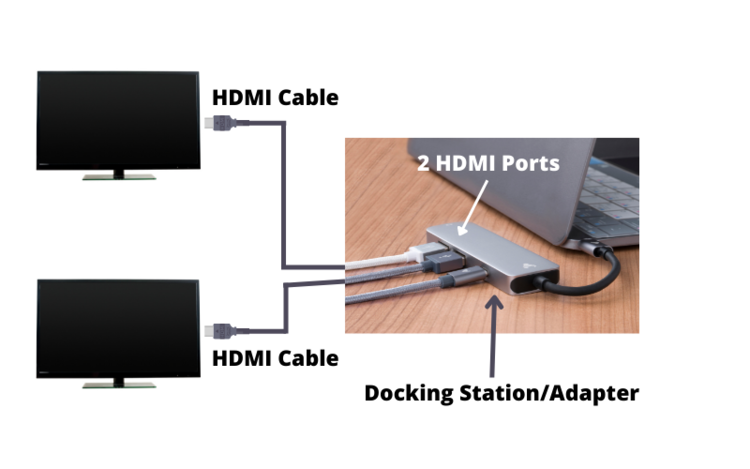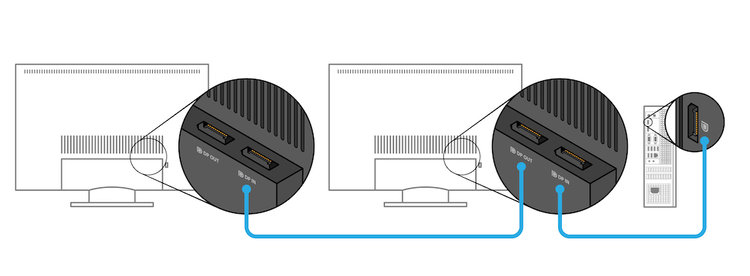How To Connect Two TVs To Display the Same Picture? Plus, Setup Displays Different Pictures

What To Know
- There are two main methods for connecting two TVs with HDMI: using an HDMI splitter to display the same image on both TVs or using a docking station to show different images on both TVs from the same source.
- You cannot daisy chain two TVs with HDMI because HDMI technology does not support it. TVs also lack HDMI OUTPUT ports, making daisy chaining impossible.
Discover how to link two TVs using HDMI to create dual displays from a single input source.
Let’s delve into the steps to optimize your viewing setup.
| Method | Supported Interfaces | Materials | Setup |
| Dual TV Setup Displays the Same Picture From a Single Source | Video & Audio |
|
|
| Dual TV Setup Displays Different Pictures | Video & Audio |
|
|
Quick Navigation
1. Dual TV Setup Displays the Same Picture From a Single Source
You can connect two TVs to the same input source with an HDMI splitter to display the same image on both screens.
Diagram

Materials Needed
- HDMI-Compatible Input Source
- HDMI Splitter (The model comes with one HDMI cable)
- Two additional HDMI cables
- Two HDMI-Compatible TVs
Instructions and Setup
Step 1: Connect the HDMI Splitter to Your Input Source
Plug one end of an HDMI cable into the HDMI splitter’s INPUT port.
It’s very important that you put the HDMI port in the INPUT port, as it will not function if placed in the INPUT port.
Then place the other end of the HDMI cable into your input source’s (e.g. laptop, monitor, etc) HDMI port.
Step 2: Connect Both TVs to the HDMI Splitter
Now you’re ready to connect both of your TVs to the HDMI splitter.
First, plug one HDMI cable into one of your TV’s HDMI ports. Then, plug another HDMI cable into the other TV’s HDMI port.
Next, plug both ends of the two HDMI cables into the splitter’s OUTPUT ports.
Step 3: Change the TVs’ Inputs
You’re almost there!
Make sure both TVs are plugged in and turned on. Now is also a good time to check that your input source is turned on.
Then change your TVs’ inputs to HDMI. TVs usually have several HDMI inputs as each one corresponds to one of their HDMI ports.
You’ll know you’ve found the right HDMI port when your input source is displayed on-screen.
2. Dual TV Setup Displays Different Pictures
If you want two TVs to display different pictures from the same input source, you will need to use a docking station.
Most modern laptops support dual-display setups, allowing you to display separate images on each TV screen.
Let’s learn how!
Diagram

Materials Needed
- USB-C or USB 3.0 Compatible Input Source
- Docking Station
- Two HDMI Cables
- Two HDMI-Compatible TVs
Instructions and Setup
Step 1: Connect the Docking Station to Your Laptop/Monitor
Plug the docking station’s cable into a compatible port on your laptop.
The docking station linked above has a built-in USB-C cable.
Step 2: Connect Both TVs to the Docking Station
Now that your docking station is connected to your input source, it’s time to connect your TVs.
Attach one end of an HDMI cable to one of your TV’s HDMI ports. Then, connect the other end to one of the docking station’s HDMI ports.
Next, repeat this process for the other TV using another HDMI cable.
In the end, your TVs should both be attached to the docking station with two separate HDMI cables (see diagram above).
Step 3: Power the Docking Station (If Needed)
Some docking stations need to be powered and come with a power cable.
If your docking station comes with a power cable, plug one end into its power port (often labeled Power for your convenience). Then, plug the other end into a wall outlet.
You may need to use a USB power adapter if it comes with a USB power cable.
Step 4: Change the TVs’ Inputs
Now that all of your hardware is set up, all you need to do is change the TVs’ inputs.
Check that the TVs and your monitor/laptop are powered or charged.
Then use the TVs’ remotes to change their inputs to HDMI 1, 2, etc., so that they display your input source’s screen.
Now you can select which photos are displayed on which TV!
Can You Daisy Chain Two TVs with HDMI? (Dual Setup)
No, you can not daisy chain two TVs with HDMI.

While daisy chaining will work for some monitors, it will not work on TVs for two reasons.
The first reason is that HDMI technology does not support daisy chaining. Daisy Chaining is only supported by devices with DisplayPort or Thunderbolt.
TVs have neither of these ports, making it impossible to daisy chain them.
The second reason is that TVs do not have HDMI OUTPUT ports. This prevents you from connecting one TV’s OUTPUT port to another’s INPUT port, creating a daisy chain.
Instead, you would be plugging both ends of an HDMI cable into two INPUT ports, which would only lead to a No Signal message on-screen.
This makes the only viable options for connecting two TVs to the same input source using an HDMI splitter or a docking station.
Yesenia Achlim is a technical copywriter and editor with a focus on AV equipment. She aims to break down complicated topics and make technology accessible, no matter your technical expertise. When she’s not teaching you how to replace a projector lamp, you can find her reading and baking.


Can I link two tvs using 1 HDMI with tv number one(1) as the source?
Hi Thor,
Great question! The setup you mention is Daisy Chain and the short answer is No. Daisy Chaining is only supported by devices with DisplayPort or Thunderbolt. We have updated the piece to answer your question: https://pointerclicker.com/can-you-connect-2-tvs-together-with-an-hdmi-cable/#Can_You_Daisy_Chain_Two_TVs_with_HDMI_Dual_Setup.
Can I connect two tvs to my windows 10 computer using a docking station using a USB 3 USB C cable?